Discharge and post-explosion behaviors of electrical explosion of conductors from a single wire to planar wire array
Chen LI (李琛), Ruoyu HAN (韓若愚),?, Yi LIU, Jinlin ZHAO,Yanan WANG, Feng HEand Jiting OUYANG (歐陽吉庭)
1 Research Center for Electrostatics and Applications, Beijing Institute of Technology, Beijing 10081,People's Republic of China
2 State Key Laboratory of Advanced Electromagnetic Engineering and Technology, Huazhong University of Science and Technology, Wuhan 430074, People's Republic of China
3 State Key Laboratory of Electrical Insulation and Power Equipment, Xi’an Jiaotong University, Xi’an 710049, People's Republic of China
Abstract This work deals with an experimental study of a Cu planar wire array (PWA) in air and water under the stored energy 300–1200 J.A single Cu wire is adopted as a controlled trial.Four configurations of PWA and a wire with the same mass (cross-section area) but the different specific surface areas (15–223 cm2 g?1) are exploded.The transient process is analyzed using high-speed photography in combination with the results of optical emission and discharge.Discharge characteristics revealed that PWA always has a higher electric power peak, early but higher voltage peak, as well as faster vaporization and ionization process than the single-wire case.Two to three times stronger optical emission could be obtained when replacing the singlewire with PWA,indicating a higher energy-density state is reached.Phenomenologically,in both air and water, single-wire load tends to develop a transverse stratified structure, while PWA is dominated by the uneven energy deposition among wires.Finally, the synchronism and uniformity of the PWA explosion are discussed.
Keywords: electrical explosion, wire array, metal plasma, plasma radiation, shock wave
1.Introduction
Electrical explosion of wire (EEW) occurs when applying an appropriate pulsed current through a relatively fine conductor(usually a metallic wire), which is a main approach for dense Z-pinch research[1,2].During an electrical wire explosion,the wire will undergo a series of state transitions from a solid to a liquid,then a vapor,and finally a plasma with significant volume expansion in both vaporization phase and the subsequent plasma phase.In the meantime, the electrical and thermodynamic parameters of the material (load) change within a broad range.Intense optical emission [3] and shock wave [4] will be produced in this process.
During the past few decades,there has been a great interest in EEW for both basic research and practical applications including topics of Z-pinches[5,6],warm dense matter(WDM)[7], equation of state [8], preparation of nanopowders [9], and generation of high power x-ray[10].The electrical explosion of conductors driven by the pulsed current can also be used to generate dense plasmas and simulate the effects of explosions in the laboratory.Therein, transient dynamic processes of phase transitions and ionization, accompanied by various instabilities,appear complex physical phenomena.Driven by large pulsed facilities,wire array Z-pinch can obtain powerful x-ray radiation which can be used to drive inertial confinement fusion and investigate high energy density physics (HEDP) [11].Particularly,planar wire array(PWA)has been noticed and investigated in the last few years for its simplicity of structure and diagnosis.Kantsyrev et al [12] used PWA to investigate dense plasma dynamics and found that there has a strongly inhomogeneous on PWA plasma in micrometre level or smaller with a chain of hot spots which can radiate much more energy than the kinetic energy of imploding plasma.Safronova et al[13]studied x-ray radiant efficiency with different metals,experiment indicated the x-ray yields from mid-atomic-number (Ag) exceed twice those from low-atomic-number (Al) produced by PWA Z-pinch plasmas.Sheng et al [14] used PWA with a mixture of dielectric-coated wires and bare wires to observe the pinch process.They found that the surface insulation can increase the deposited energy and influence the evolution of ablation,implosion, and stagnation, while made little effect on magnetohydrodynamic instabilities or radiation yields.Wu et al[15] obtained an imploding plasma without ablation and a negligible trailing mass of two-wire Al arrays with the method of preheating.
Different from Z-pinch studies focusing on the later implosion process of plasma after the wire explosion,in practical fields, such as generating shock waves, the earlier stage involving explosion and WDM is more concerned.Krasik et al[16]obtained a converging shock wave with the pressure ~200 kbar near the implosion axis by an underwater explosion of a cylindrical Cu wire array under the stored energy ~4.2 kJ.Other configurations of wire array explosion were explored, and an extreme state of water in a spherical implosion center which was characterized by pressure of ~6 TPa was obtained with numerical calculation and experiment [17].In order to generate extremer matter condition in the vicinity of implosion, Bland et al [18] exploded cylindrical Cu wire array in polyester and higher pressure about 2–4 times was obtained than in water.Rososhek et al [19] conducted the explosion of cylindrical Al wire array in high concentration H2O2solutions and indicated that higher pressure and temperature were achieved in the vicinity of the implosion due to the additional energy produced by the detonated hydrogen peroxide.
According to the previous researches, the wire array explosion was considerably complex and influenced by many factors.The ablation stage and implosion dynamics were significantly affected by the wire spacing regarding the possible interactions between explosion products in the array which had been concerned in Z-pinch field [15].In fact, the wire array load configuration, namely the wire numbers,specific surface areas, would also make effects on the phase explosion and energy deposition process which was critical for generating shock wave and nanoparticles [20–22].Nevertheless,there is still not enough attentions to wire array explosion in some ways.The influencing factors for exploding a wire array in a medium have yet to be systematically investigated, and wire explosion in medium will become more complex because of the interactions between the discharge channel (DC) and the surrounding matter.Studying the dynamics of wire array explosion in medium in details not only benefits for the industrial applications, but also has positive enlightenments to Z-pinch and HEDP fields.
In pilot experiments, we found that the discharge and explosion behaviors of electrical explosion have prominent differences between a single wire and a PWA.Under the same stored energy and wire mass (initial current density),both the discharge and radiation characteristics show obvious correlations to the surface process of the exploding wire[22].It is suspected that apart from the skin-depth effect at the beginning of the discharge [23] the phase transition and growth of instabilities play the significant role [24].In this study, therefore, experiments were carried out with a copper PWA in air and water driven by a micro-second timescale pulsed current source under the stored energy from 300 to 1200 J.A copper single wire with the identical mass was also exploded under the same experimental condition as a comparison.The exploding characteristics of both two loads were investigated through the electrical parameters,light emission,and self-emission images.Moreover, it was found that the specific surface area influenced deeply on the electric explosion process.Therefore, four types of loads with different specific surface areas were exploded and discussed.
2.Experimental setup
The schematic of the experimental setup and configurations is illustrated in figure 1.
A 6 μF pulse capacitor charged from 10 to 20 kV(300–1200 J stored energy) was used to generate a microsecond time-scale current pulse.When the capacitor was first charged to the required voltage and then the spark switch was triggered,the pulsed current was transferred to the wire array load through a coaxial cable, finally drove the electrical explosion.The schematic of the electrodes was shown in dashed line-box in figure 1.The wire was fixed on one electrode firstly,then placed the wire into grooves one by one,finally tightened the wire and fixed on the other electrode.The interval between each groove was 2 mm.The distance between fines wires can be adjusted by grooves, and it was settled as 2 mm in our experiments.Straight wires with equal intervals which contacted greatly with electrodes can be obtained by this method.Four load types were used in our experiments, and the essential parameters were listed in table 1.A high-speed camera (NAC, HX-3), synchronized with the beginning of discharge,was developed to record the self-emission images of wires explosion.A LED light with power 200 W was used as a backlight source when exploding underwater.Optical emission signals were measured by silicon photodetectors (ET-2030).The voltage and current were obtained with PVM-5 (bandwidth of 80 MHz) and Pearson 101 Coil (bandwidth of 4 MHz).The resistive load voltage may be estimated as:

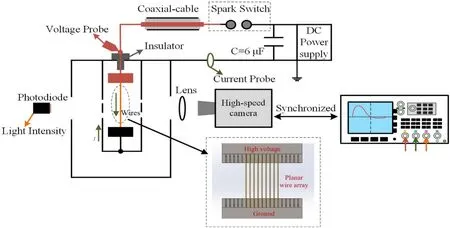
Figure 1.Schematic of the experimental setup.

Table 1.Parameters of load types used in experiments.
where URis the resistive voltage drop of the wire load and U is the measured value directly by the voltage probe.LSrefers to the inherent inductance of the load structure and LWrepresents the stray inductance of the wire.I is the total circuit current.Validity of voltage and current is examined by testing a 15 Ω HVR ceramic resistor [25].
3.Experimental results
3.1.Discharge characteristics
The experiment considered two types of loads.A copper PWA consisted of nine wires of 100 μm diameter, and 4 cm length,where the interval of each fine wire was 2 mm.The other one was a 300 μm diameter, 4 cm length copper single wire.The two loads have the same mass and cross sectional area.A group of shots were carried out with a variety of the initial stored energy of 300 J(10 kV),400 J(11.5 kV),500 J(12.9 kV),600 J(14.1 kV), 700 J (15.3 kV), 800 J (16.3 kV), 900 J (17.3 kV),1000 J (18.3 kV), 1100 J (19.1 kV), 1200 J (20 kV).Three repetitive shoots were made for each case, and the error bars were given in figures 2 and 3.The representative waveforms of wires explosion in atmospheric air with increased initial stored energy were given in figure 2.For a quantitative evaluation,the statistics of key electrical parameters of two loads explosion were compared.Among these parameters, texrepresented the moment of voltage peak and Edwas the deposited energy up to tex.The energy for fully vaporizing the wires under the certain mass was given in figure 2(d).

Figure 2.Statistics of the electrical parameters for exploding a single wire and a planar wire array in air with an initial stored energy from 300 to 1200 J.(a) Typical waveforms of voltage and current, (b) voltage peak and peak moment, (c)resistance peak and its FWHM,(d) power peak and deposited energy before tex.

Table 2.Electrical parameters of different types of loads.
With the increased stored energy, the current rise rate increases rapidly from ~4.7 to ~11.4 A ns?1for wire array,and ~4.6 to ~10.9 A ns?1for single wire at the beginning of discharge.The current rise rates of two different loads under each charge voltage are similar due to the mostly equal parameters, namely initial resistance and inductance.The voltage peak boosts as well, which increases from ~37.5 to~61.3 kV for wire array, and from ~29.5 to ~44.8 kV for single wire.The power peak corresponding to the increase of voltage and current boosts significantly from ~307 to ~1010 MW for wire array and from ~236 to ~828 MW for single wire.A higher energy deposition efficiency is achieved with the increased stored energy, and it should be responsible for the early appearance of voltage peak,as shown in figure 2(b).The resistance is an important parameter to qualitatively characterize the status of DC.For single wire explosion,the resistance of DC is relatively higher under insufficient stored energy, then deceases gradually and maintains almost constant with the increased stored energy.As for wire array explosion, however, no regular tendency is observed.Furthermore,the FWHM of resistance may represent the duration of vaporization and ionization/breakdown phases, and it seems to be not influenced by the changed stored energy which stabilizes at around ~0.28 μs for single wire and~0.10 μs for wire array, as shown in figure 2(c).Deposited energy before voltage peak moment, namely Ed, is a crucial parameter for shock wave application.An increased Edis acquired from ~114.2 to ~204.1 J for single wire and it exceeds the energy for full vaporization of the load after the stored energy 500 J.The Edalso boosts from ~84.6 to~137.5 J for wire array, whereas it is lower than the full vaporization energy all the time,as well as lower than that of single wire explosion.It has to say that the explosion begins to be dominated by the plasma process especially at higher stored energy, and Edcan hardly increase significantly.A novel phenomenon is that wire array explosion always has a higher power peak, a smaller texand a shorter FWHM of resistance than that of single wire explosion which means a higher energy deposition efficiency, a faster phase change process with an early breakdown and a shorter duration from vaporization to ionization, respectively.From the statistics of three shoots, a relatively large dispersion of parameters is observed in wire array explosion, however, hardly occurs in single wire explosion.It may be caused by the ‘partial explosion’case which will be described in discussion section.
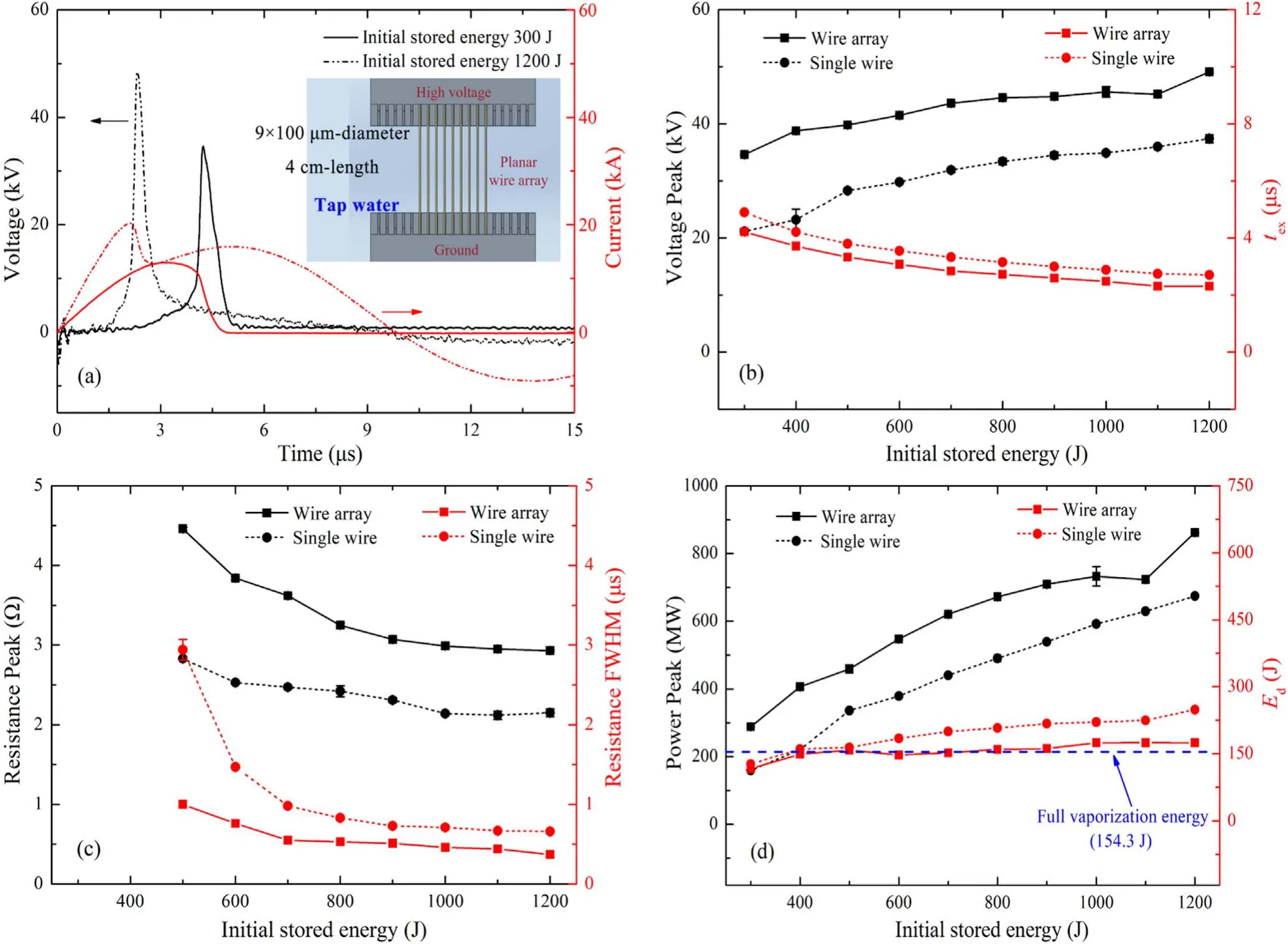
Figure 3.Statistics of the related electrical parameters for exploding a single wire and a planar wire array under water with an initial stored energy from 300 to 1200 J.(a) Typical waveforms of voltage and current, (b) voltage peak and peak moment, (c) resistance peak and its FWHM, (d) power peak and deposited energy before tex.
Underwater explosions of both two loads were also implemented and the statistics of key electrical parameters were compared as well.Another purpose for underwater explosion is to eliminate the possibility of early breakdown in air by the fast diffusion of metallic vapors when exploding wire array which will also cause the phenomenon mentioned above.
The variation tendencies of electrical parameters of underwater explosion are similar with the air explosion partly.With the increased stored energy, current rise rate at the beginning of discharge increases from ~4.1 to ~9.4 A ns?1for wire array, and ~3.7 to ~8.9 A ns?1for single wire.The moment of voltage peak varies from ~4.2 to ~2.3 μs, and peak value is from ~34.5 to ~48.8 kV for wire array, as for single wire the moment changes from ~4.9 to ~2.7 μs, and the peak value increases from ~20.4 to ~37.3 kV.As a result,the energy deposition efficiency also boosts manifested as an increased power peak which reaches the maximum ~865.3 MW for wire array explosion, and ~673.1 MW for single wire explosion.However, there are also some differences between air and water explosion.From the typical electrical waveforms under different discharge voltages, the discharge model changes from ‘Periodic Discharge’ to ‘Aperiodic Discharge’.The resistance of DC at voltage peak moment under the discharge voltage 10 kV and 11.5 kV is 3.3 Ω and 2.7 Ω, respectively.However, the maximum value of resistance does not appear at this moment and continues to increase rapidly when the initial stored energy is insufficient.Once the initial stored energy is at a lower level, the voltage at both ends of the wire is not enough to breakdown after vaporization, therefore, the metallic vapors are at a low-ionization state instead of a high-ionization discharge plasma channel.Different from air ambience, DC is so hard to expand due to the weak compressibility of water that it will maintain at a low-conductivity status.Moreover, the FWHM of resistance of underwater explosion is characterized as a decreasing trend with the increased stored energy, and is three and five times larger than that of single wire and wire array explosion in air,respectively.The blunt falling edge of resistance is responsible for the wider FWHM under water explosion which represents a long-time plasma process with a decreasing resistivity, as shown in figure 4.The deposited energy before voltage peak moment,Ed,increases from ~121.7 to ~173.1 J for wire array, and from ~129.1 to ~232.1 J for single wire.The Edachieves a higher value under water explosion than that of air explosion.Different from the air explosion, the Edis almost equal between two loads under relatively small stored energy(300–500 J),however the gap enlarges with the increased stored energy.It has to mention that the phenomenon occurs as well under water explosion manifested as a higher power peak, an early breakdown moment and a narrower FWHM for wire array explosion.
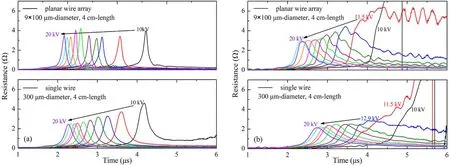
Figure 4.The typical resistance waveforms of both two loads explosion in (a) air and (b) water.

Figure 5.Typical light intensity of two loads in air(a)wire array,(b)single wire,and under water(c)wire array,(d)single wire with different initial stored energy.
3.2.Plasma radiation characteristics
Optical radiation is an important diagnosis method which can describe plasma state qualitatively.The early breakdown and the short-time duration between vaporization and ionization will also be reflected in the plasma processes.Therefore, the light emissions of both two loads exploding in air and water with the increased stored energy were detected, as shown in figure 5.
The light emission in different medium shows discrepant behaviors.Explosion in air is characterized as a rapid increase of light intensity and then a segmented decline which reflect the stages of ionization, expansion and quenching.Underwater explosion is characterized as two radiation pulses.A short-time weak pulse and a long-time intense pulse.Because of the weak compressibility of water, the DC undergoes a slow expansion and results in a last-time radiation after discharge.From the waveforms of the light emissions, some similarities as well as differences are observed between single wire and wire array explosion.Light intensity of explosion in air can be seen in figures 5(a) and (b).With the increased stored energy, the light intensity increases continuously and the radiation duration time is prolonged for single wire explosion, however, the variation trend of wire array explosion is irregular.This phenomenon may also attribute to wires exploding incompletely which will be illustrated in discussion section.On the whole, the light intensity of wire array explosion is stronger than that of single wire explosion at each discharge voltage.Light emission underwater can be seen in figures 5(c)and(d).Sarkisov et al[26]and Grinenko et al[27]had studied the light emission in vacuum and water,respectively.They found that the first narrow pulse corresponded to the wire explosion and started with the onset of wire expansion, and considered that the source of the first peak was assumed to be the surface of the heated wire material.The second long-time light emission caused by the hot microparticles may be generated from the entire volume of the DC,and related to the expand speed of the DC.The first light emission has distinct differences for two loads in our experiments that the peak value boosts with the increased stored energy for wire array, however, mostly not varies for single wire except the situation at charge voltage 10 kV.Otherwise, the peak of the second last-time radiation boosts with the increased stored energy for both loads, however the second peak of single wire is much stronger than that of wire array which is totally opposite to the first pulse.Increased deposited energy corresponds to the higher temperature of the hot drops, and the higher deposited energy of single wire explosion may result in a more intense radiation peak.Furthermore, the increased radiation rise rate may relate to the faster expansion velocity of DC Finally,it has to mention that the duration time of the second emission peak of single wire is more than twice longer than that of wire array.
3.3.Effect of specific surface area
Previous research indicated that the pulse current rise rate and circuit parameter (inductance) would influence the electrical characteristics of wire explosion [28].In our experiment, the current rise rate is almost equal, and the inductance varies so small about several tens of nH that hardly affect the total circuit parameters.However, a higher energy deposition efficiency, an early breakdown moment and a faster vaporization/ionization process were acquired when replacing a thick single wire with separate fine wires.In order to investigate the probable reasons, experiments were designed both in atmospheric air and tap water.Four types of loads with the same mass and cross sectional area but different specific surface areas were selected.
Fixed the initial stored energy at 300 J (10 kV), the typical waveforms of discharge parameters can be seen in figure 6.The load configurations are given in figure 6(a) and the numbers nearby the curves represent the corresponding specific surface areas.The essential parameters of different types of loads were listed in table 2.
In order to avoid the early breakdown of fine wires in wire array because of the faster expansion speed in air which may result in similar phenomenon, underwater explosion with different specific surface areas was also carried out.Experiment shows that the explosion process is obviously accelerated by the increased specific surface area, which can be proved by the early appearance of voltage and power peaks both in air and water explosion.The voltage peak appears earlier from ~4.2 to~3.2 μs in air,and from ~4.9 to ~4.2 μs in water.FWHM of voltage decreases from ~0.45 to ~0.12 μs in air, and from~0.77 to ~0.46 μs but increases to ~1.02 μs at specific surface area 223 cm2g?1in water.This may represent a faster process of phase change and ionization/breakdown.Furthermore, the power peak increases both in air and water which means the energy deposition rate is enhanced, however, decreases with copper foil explosion.Copper foil can be considered as a limitation of wire array with infinite fine wires,and there may exist an optimal load with a certain specific surface area under the same mass.Though, it has to say that foil explosion is somewhere different from wire array and single wire [29].The deposited energy before breakdown,Ed,seems to decrease with the increased specific surface area,and this reductions are severe in air but slight in water.Furthermore, the onset of the light emission appears early both in air and water which indicates an earlier ionize/breakdown process.The light intensity is also enhanced with the increased specific surface area.In general,based on the nearly equal current rise rate and peak value, as well as the mass and cross section area of four loads, the variation of the specific surface area may cause these phenomena mentioned above.
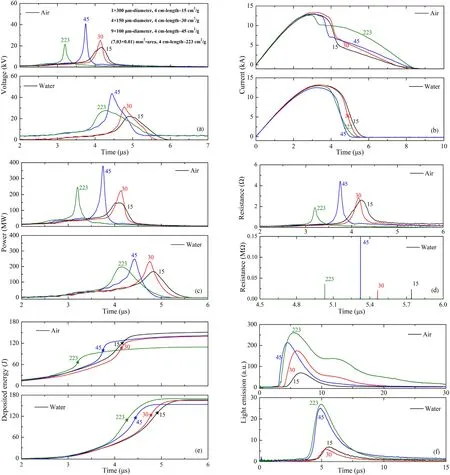
Figure 6.Voltage (a),current(b),power(c),resistance (d),deposited energy(e),light emission (f)waveforms of representative shots in air and water with different specific surface areas under 300 J stored energy.
3.4.Spatial-temporal evolution
In addition, self-emission image diagnosis was also implemented to investigate the spatial-temporal evolution of wire explosion dynamics.Figure 7 gives the circuit current, light intensity and self-emission images of four different loads in air under the fixed initial stored energy 300 J.The interval between two successive frames was 4.54 μs,and the exposure time of each frame was 1.1 μs.Different current waveforms are obtained for different specific surface areas.Current is almost cut off in single wire explosion,and in this case,there hardly exists a plasma process, as shown in figure 7(a).However, the current begins to oscillate with the increased specific surface area, and the discharge turns into periodic discharge model which means a relative sufficient plasma process with a relatively high-conductivity DC.A raised light intensity and a slower falling rate are obtained as the specific surface area increasing.From self-emission images, there are obvious distinctions about the early DC structure between single wire and wire array.For single wire explosion, a thin bright column appears in the initial wire area with numerous jets in frame 1, and an obvious nonuniformity is observed in later frames.The formed DC becomes more uniform with the increased specific surface area, however, the boundary of the DC is irregular in load type No.2 of figure 7(b).In addition,the quenching processes are obviously different for four loads explosion.In load types No.1 and No.2,the light intensity of frames 3–5 weakens synchronously as the evolution of the DC In load type No.3 of figure 7(c), the light intensity decreases from the both two sides firstly and then towards the center, nevertheless, the variation trend is totally opposite in load type No.4 of figure 7(d).Obviously,the PWA explosion is very different from single wire explosion.According to the former researches, the current of each wire in planar array is inhomogeneous and exists distribution between wires whatever exploding in vacuum [30] or water [31].For PWA explosion, the current distribution will concentrated more in periphery wires and less in the center wires.We speculate that two possible reasons may result in this phenomenon in slow explosion (several tens μs).One is the nonuniform distribution of electric field,especially in the transverse boundaries of the array due to the noncoaxial geometry of the planar array.The peripheral wires will be ionized and breakdown early and easily under the stronger field.Other possible reason is that the products of the peripheral wires can expand without obstruction which will lead to a rapid increase of conductivity.The DCs of inner wires are compressed continuously by the pressure wave due to the outer wires explosion, therefor, resulting in a relatively low-conductive state.During the stages from phase explosion to breakdown,the resistance increases drastically and the current will redistribute more obvious.The re-distribution of current with higher density of the outer wires may not come from the distribution of magnetic field,because the current is too small to drive implosion.However, it is regretful that the current re-distribution cannot be observed clearly in our experiment because of the limitation of the diagnostic device.

Figure 7.Current waveform, light intensity and self-emission images with different specific surface areas 15 (a), 30 (b), 45 (c), 223 (d)cm2 g?1 in air under 300 J stored energy.

Figure 8.Current waveform, light intensity and self-emission images with different specific surface areas 15 (a), 45 (b) cm2 g?1 in water under 300 J stored energy.
The self-emission images of the underwater explosion were acquired as well under the fixed stored energy 300 J,and the typical images of load types No.1 and No.3 were shown in figure 8.Due to the low intensity of light emission of underwater explosion, a high power (200 W) LED light could be used as the backlight source.The interval between two successive frames was 2.32 μs, and the exposure time of each frame was 0.97 μs.From the typical discharge waveforms, both of the two loads explosion are aperiodic discharge, and the currents are cut off.However, the peak moment of current of wire array explosion appears earlier than that of single wire explosion which are ~3.05 μs and~4.03 μs, respectively.The light emission of two loads only exists one pulse, and a stronger intensity as well as a longtime duration is acquired in wire array explosion.The dynamics of underwater explosion is clearer than in air because of the slow expansion speed of DC The instability of single wire explosion underwater develops seriously from those images of figure 8(a).The wire glows slightly, especially near the high voltage electrode at the early stage around the drop point of the current, whereafter a flash occurs with the appearance of asynchronism manifested as the different expansion speed at each section.With the evolution of the DC,these asynchronism intensifies and occurs particularly in the middle part, as shown from frames 2 to 8.Moreover, a spheroidal shock front is detected and marked in white dash lines which can be seen in frames 7 and 8 of figure 8(a).As for wire array explosion, the DC flashes at around 3.51 μs which is earlier than single wire explosion, and the DC evolves uniformly during the whole expansion processes.In addition, the non-overlapping planar shock fronts are acquired near the wire array, as shown in frames 4 and 5 of figure 8(b).The separate shock fronts generated by the individual wires explosions are observed obviously which correspond to the results of Rososhek [31].
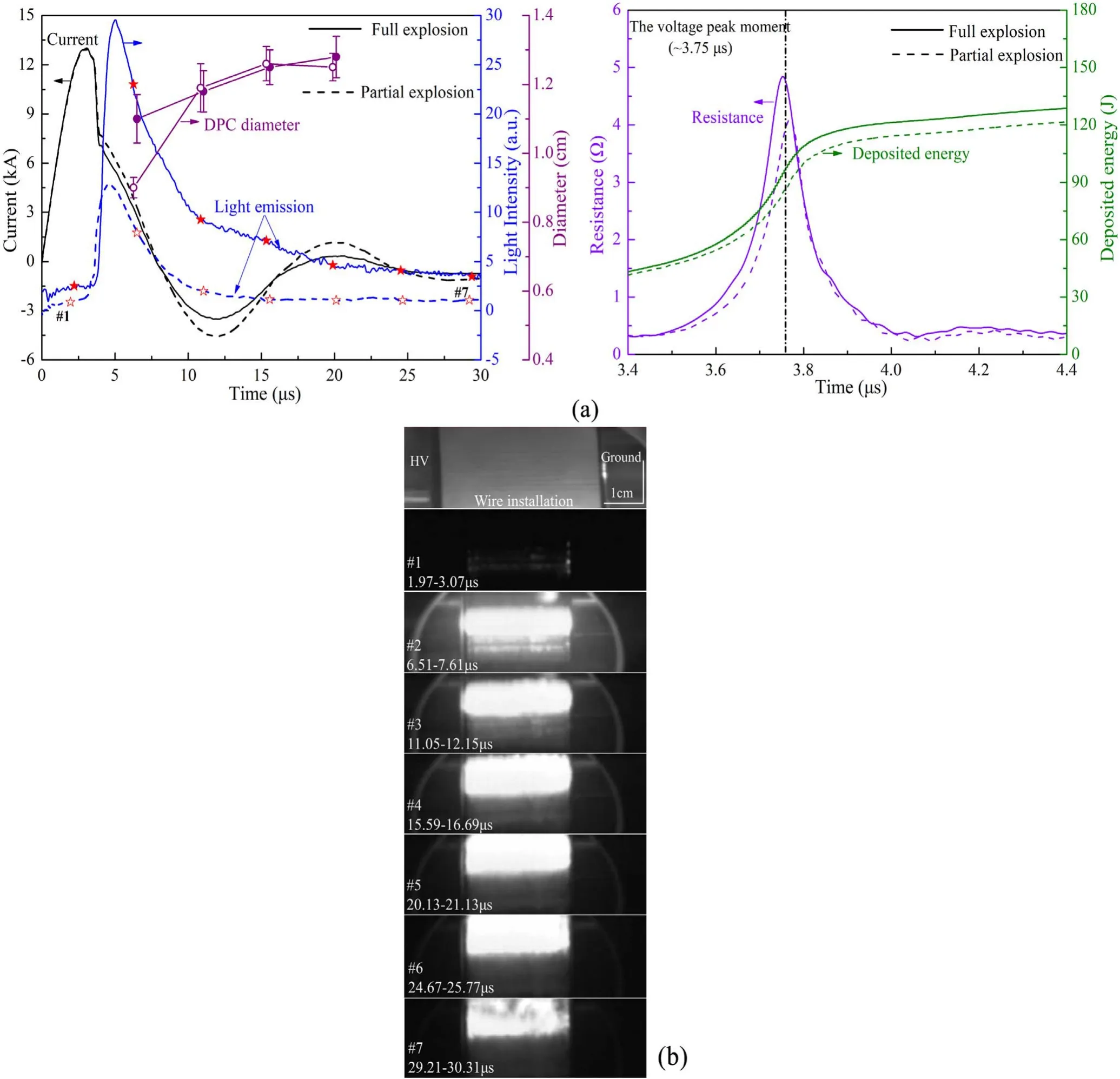
Figure 9.The differences of electrical characteristics between the two evolution modes of DC(a),and the self-emission images of the partial explosion (b).
4.Discussion
Previous research indicated that the discharge process existed asynchronism in PWA explosion.Explosion process as well as the light radiation and shockwave accompanied will be different as a result.Diverse evolution of DC for PWA explosion consists of nine 100 μm diameter, 4 cm length wires was observed in our experiment, which can be seen in figures 9(c)and 7(c).The two different evolution modes can be called as‘full explosion’ and ‘partial explosion’ in our experiment, and it may be a random phenomenon,when the condition of some regions tends to breakdown easily.The corresponding light intensity and electrical parameters are illustrated in figures 9(a)and (b).

Figure 10.The discharge images(a)and corresponding contour map(b)of single wire and planar wire array of nine 100 μm diameter,4 cm length wires under the stored energy 300 J.
From the self-emission images for partial explosion situation.As seen in frame 1, the bottom part of fine wires glow slightly, however the other parts can hardly be detected.This moment corresponds to stage that current begins to decrease which represents the vaporization process, and a portion of metallic vapors may ionize in this stage.From frames 2 to 7, intense light emission can be observed which means ionization/breakdown occurs, however, the DC only forms in the top part of the wire array.The resistance of the section who undergoes phase changes early will increase rapidly so that the current will redistribute to other sections.Once the DC is formed,the former section will be short-circuit.Full explosion is also captured in figure 7(c), complete ionization/breakdown process occurs and the DC forms in nearly the whole wire array area.Pay attention to the light radiation and electrical characteristics,the turning point of current in the first period reaches a smaller value for full explosion which means a more sufficient vaporization process.As illustrated in figure 9(b),the resistance rising edge of the full explosion rises faster than partial explosion,however the falling edge is mostly identical.Besides, a higher peak and a wider FWHM of resistance are observed for full explosion.Because the vaporization stage always has a greater energy deposition rate, the deposited energy before voltage peak moment is higher than partial explosion about 12 J(~12.4%).Light emission between two situations also exists obvious differences.In our previous work [3], we have clarified the contribution of different explosion stages to the light emission.Therefore the more sufficient ionization of explosion products and the ‘volume effect’(greater radiation flux density)for the early stage of DC may be responsible for the higher radiation peak of full explosion.In addition,the further deposited energy may be the reason for the broader radiation pulse width.Finally, this random process may cause the irregular radiation growth in wire array explosion with the increased stored energy which can be seen in figure 5(a).
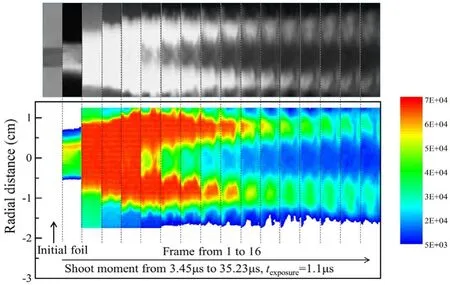
Figure 11.The evolution of the discharge channel of the foil explosion in air under 300 J stored energy.
The physical process during EEW is surely complex with nonuniform metallic phase transformations.Previous research indicated that the complete evaporation of a conductor did not occur even in experiments with enough deposited energy [32].Tkachenko et al[33]proposed a‘phase transition wave’model.They considered that volumetric boiling was not possible even in case of quasi-uniform regimes of heating because of the nonuniform pressure distribution, and the phase transition propagated like a wave from the outside boundary to the center of a wire.Romanova et al[34]proposed that a sharp change would occur in the matter transformation regimes during the propagation of the unloading wave who appeared on the surface of a metal heated by pulse current at very beginning of its evaporation toward the axis.Therefore, due to the nonuniform phase transitions and the characteristic of the wave propagation process, the increased specific surface area may accelerate the propagation of the wave and result in a faster phase transition process.In our experiment, the current rise rate is mostly equal for four loads with different specific areas, and the change of inductance can be negligible compared with systematic inductance.From the discharge waveforms in section 3.3, the phase explosion moment occurs early, moreover, the FWHM of voltage which represents the duration from the two-phase state after phase explosion to the ionization/breakdown of metallic vapors and then forms a DC shortens obviously.Certainly, the breakdown moment comes earlier which can be proved by voltage peak moment.In addition,a relatively uniform discharge process was obtained with the increased specific surface area from the self-emission images.Figure 10 gives the comparison between a single wire and wire array explosion of nine fine wires at early stage of DC in air.An intense inhomogeneous distribution of light emission is detected as a stratified structure in single wire explosion, however, the DC is considerable uniform in wire array explosion as well as a clearer and smoother boundary of DC.
The evolution of the DC of the foil explosion was further disposed in figure 11.Visible difference can be found in foil explosion whose DC is quite uniform in the early stage,however,the distribution of light intensity shows as a hollow structure at subsequent quenching stage.The central dark area may be caused by the high density exploded products.Moreover,the‘Optically Thick’[35]is satisfied at this situation and the light emission is absorbed by the high density plasma channel.The self-emission diagnosis is limited only by the detection of ionized material,and further exploration about the density distribution is needed to verify the assumption in future work.Furthermore,it is worth nothing that the light intensity appears as a stair-stepping distribution with an attenuation at the boundary for each loads explosion,as shown in figures 10(b)and 11.Previous researches indicated that the low-density material from the near-surface region was located on the expansion front and the main fraction was left behind [34].Therefore, the above stair-stepping distribution of light intensity may attribute to the different density distribution of explosion products.
5.Conclusion
This paper presents the experimental results of exploding a single copper wire and a planar copper wire array in air and water with different initial stored energy.The differences of electrical and optical characteristics between the two loads were compared.The effect of the specific surface area was investigated and analyzed.The main findings are as follows.
(a) The variation tendencies of electrical parameters of the wire array explosion were similar to the single wire explosion.The higher electric power and deposited energy were obtained with the increased stored energy.Relatively large dispersion of electrical parameters appears when exploding wire array in air because of the occurrence of the ‘partial explosion’.Moreover, compared to the single wire explosion under the same experimental condition, wire array explosion always had a higher energy deposition rate and a faster electrical explosion progress manifested as a greater electric power,an early breakdown and a short-time duration from vaporization to plasma stages.
(b) The light emission intensity boosted with the increased stored energy for single wire explosion in air,however,no regular trend was obtained for wire array explosion which may be caused by the random exploded section for each shoot.However,the light intensity of wire array explosion was always higher than that of single wire explosion.Moreover, two radiation pulses were observed under water explosion.The first peak of wire array explosion was still higher than that of single wire explosion.However, the second peak caused by the hot microparticles was obviously intense for single wire explosion,which may be due to the higher deposited energy than that of wire array explosion.
(c) The increased specific surface area accelerated the electrical explosion process indeed which should be responsible for the differences between wire array and single wire explosion.At a greater specific surface area,the higher energy deposition rate and the stronger light emission were achieved.Furthermore, an optimal parameter of the specific surface area may exist for achieving the greatest energy deposition rate.
(d) From the electrical explosion images, a more sufficient plasma process and a more uniform DC evolution were obtained when increasing the specific surface area.The subsequent quenching processes were also discrepant for different specific surface areas.In addition,a hollow structure of foil explosion at later quenching stage was observed.
Acknowledgments
This work was supported in part by National Natural Science Foundation of China (No.51907007), Natural Science Foundation of Beijing (No.3212034), State Key Laboratory of Electrical Insulation and Power Equipment (No.EIPE20204),and State Key Laboratory of Advanced Electromagnetic Engineering and Technology (No.AEET 2019KF006).
Data availability statement
The data that support the findings of this study are available from the corresponding author uponreasonable request.
ORCID iDs
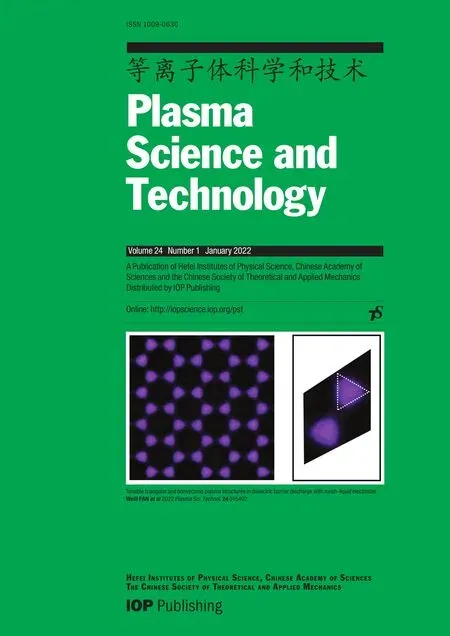 Plasma Science and Technology2022年1期
Plasma Science and Technology2022年1期
- Plasma Science and Technology的其它文章
- Design of improved compact decoupler based on adjustable capacitor for EASTICRF antenna
- W fuzz layers: very high resistance to sputtering under fusion-relevant He+irradiations
- Influence of anode temperature on ignition performance of the IRIT4-2D iodine-fueled radio frequency ion thruster
- Experimental study on plasma actuation characteristics of nanosecond pulsed dielectric barrier discharge
- A novel double dielectric barrier discharge reactor with high field emission and secondary electron emission for toluene abatement
- Plasma activated water prepared by different plasma sources: physicochemical properties and decontamination effect on lentils sprouts
